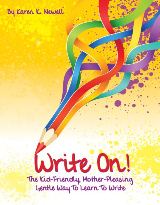Write On!: The Kid Friendly, Mother-Pleasing Gentle Way to Learn to Write was created for homeschoolers to be used with children in grades three through eight over at least three or four years. This self-contained book serves as a teacher’s manual, and no separate student books are needed as long as you are teaching no more than two or three children at a time. (Students need to be able to see the pages with examples of student writing.)
While there are one hundred lessons in the book, many of the lessons will be used at least four times at increasing levels of difficulty. (Older students starting in this program might not need to work through all lessons and all levels of difficulty.) The first three levels of difficulty are designed to help children learn to write. Students work at the fourth level once they have mastered the pertinent writing skills and are now ready to “write to learn” as they do in essays and reports.
In the first three levels, parents first assist a child to come up with ideas and ways of stating them. Parents might even do the initial writing. When you repeat the lesson at a higher level, the student is given more responsibility and less assistance each time. Older students might even complete most of their lessons independently. While some students might quickly work through all four levels, others might tackle only one or two levels in a school year.
Every fifth lesson is identified as a “Progressive Structured Report.” Their titles are bolded in the table of contents so they are easy to spot. These are the lessons that build core skills for academic writing in a sequential fashion. Write On! lessons begin with three-sentence reports and progress through various types of essays, concluding with students writing a thesis paper. The lessons in between Progressive Structured Reports (PSRs) generally work on creative writing skills. Some of these lessons might be used a number of times, but many are suitable for only one time use. The author suggests that you might begin a PSR at level one. Use the next creative lesson then shift back to the same PSR lesson at level two. Then, you would use the next creative lesson before shifting back to the PSR at level three. The student might complete the fourth of the creative lessons before tackling the same PSR at level four. This process takes place over a span of at least four or more weeks.
You can see that working through the lessons, gradually working up through the different levels, might well take a number of years if you use about two lessons per week as suggested. A suggested lesson plan order at the back of the book helps parents identify lessons that need to be paired together as well as well as a pattern for repeating PSRs interspersed with creative lessons.
I particularly like the layout of each lesson. They follow a consistent pattern that makes it easy for parents to figure out what to do each time. Each lesson is only one or two pages long. Objectives are clearly stated in a box at the top. The “objectives” box also alerts parents when a lesson is preparatory for the following lesson—teaching a prerequisite skill. This happens occasionally, and those lessons should be used relatively close together. Directions are clearly and simply stated in a box on the left. The bulk of each page features one or more samples of student responses to each assignment so that both parent and student understand what is to be done. Optional ideas are in “clouds” at the bottom of the page. Even when the actual writing assignment is new or unusual, it is simple to figure out. No advance teacher preparation is required aside from reading the eight pages of teaching information before you start using the book.
The teaching information in the lessons does not contain religious references, but occasional student samples contain Christian references. This should not be enough to deter those looking for secular resources.
Parents need to carefully read the teaching instructions at the front of the book to understand how to teach at the four different levels since this is not spelled out within the lessons themselves. Using the different levels of presentation also allows families to use the same lesson simultaneously with children of differing ages and abilities. You can even include extra lessons for older students who are ready to progress beyond where younger siblings have reached their limit. The flexibility and adaptability of this program makes it a great choice for homeschooling families.








